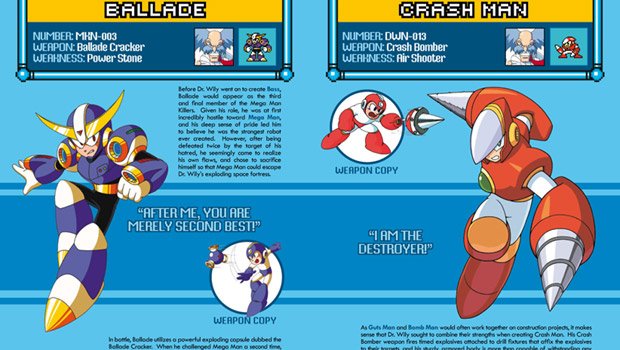The Mega Man series may have the largest cast of unique characters in videogame history. The new Robot Masters introduced in each sequel are not merely cardboard standees to be knocked over, rather they are diverse individuals with plenty of fans of their own. Though their on-screen appearances are often brief, their personalities are powerful enough to inspire the imaginations of millions of fans.
UDON’s Mega Man Robot Master Field Guide has been beset by delays month after month, to the point where it seemed like the book would be quietly cancelled. Its existence was recently reconfirmed with the announcement that PAX East attendees could pick up an early copy. Starting today, the book is available in specialty shops, followed by a wider release in the coming weeks. If you are a fan of Mega’s sometimes cool, sometimes quirky parade of android antagonists, this tome ought to give more insight into their lives and personalities than one could have ever asked for.
Naturally, I purchased a copy during PAX and read through the whole thing. In alphabetical order, the book lists every single Robot Master from the Classic series — from the numbered entries to the Game Boy games to the side stories like Mega Man & Bass and The Wily Wars — as well as the support units like Rush and the lesser-known Reggae. The character synopses, compiled from various official sources, detail each robot’s abilities, weaknesses, assigned civilian duty, and other details, such as their hobbies and relationships with other Robot Masters.
One thing the book serves to highlight is the extent of Dr. Wily’s laziness. Very few of the Robot Masters in his army are his creations, the vast majority’s having been stolen and repurposed. In addition, it’s implied that following their defeat, the Robot Masters are rebuilt and then allowed to pursue pretty much any life they choose. At their core, most of these robots are non-threatening, preferring to engage in simple hobbies like karaoke and such. Supposed enemies even turn out to be good friends, like Guts Man and Stone Man.
Some of the personality quirks are beyond bizarre. Sunstar, the final boss from Mega Man V on Game Boy, is a living doomsday weapon, yet his hobbies include following a strict dental care routine. Does that mean he actually eats food, or is he like BMO in that recent episode of Adventure Time, pretending that he is a real boy? Then there’s Punk, the Mega Man Killer from Mega Man III on Game Boy, who harbors a grudge against the Parent-Teacher Association. Uhhhh… why!? He doesn’t attend school, nor is he anyone’s legal guardian, so why does he give a flip about the goings-on of an organized body meant to foster parental involvement in school functions? That’s what makes this book so amazing! You never know what these guys are like in their private time!
All the images are official artworks from their respective games, with the exception of the Mega Man 1-6 art which comes from the Complete Works re-releases on PS1. As a result, there’s a lack of cohesion — it’s quite jarring go from a more recent piece to a less refined one that was made over a decade prior. Different games featured different artists and styles, such as the tall, lean builds of the Mega Man 7 and 8 bots compared to those from 1-6, 9, or 10. For as long as this book was in production, I was kinda hoping that all-new artwork would be produced for each character. That might be asking too much on my part, however. It’s all good, either way!
I do have to give props to The Mega Man Network. Two of their editors, David and Nadia Oxford, wrote the synopses for the Field Guide! It’s a book for fans by the fans themselves! I’m really happy that they received this opportunity! Way to put all that useless videogame trivia to work!
But enough of my blathering. Mega Man Robot Master Field Guide can be snagged for $13.99 at comic shops now, or you could scoop it from Amazon for $11.19 when it becomes available next month.
Mega Man Robot Master Field Guide Debuts! Preview! [UDON Entertainment via The Mega Man Network]


